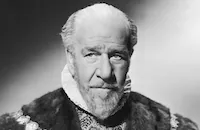Lady from Louisiana
Brief Synopsis
Cast & Crew
Bernard Vorhaus
John Wayne
Ona Munson
Ray Middleton
Henry Stephenson
Helen Westley
Film Details
Technical Specs

Synopsis
When New England lawyer John Reynolds travels by steamboat to New Orleans in the late 1800s, he falls in love with Julie Mirbeau, whose name he does not learn until they reach the dock. Julie is greeted by her father, General Anatole Mirbeau, and his right-hand man, Blackburn "Blackie" Williams. John is met by reformer Blanche Brunot, who has hired him to stop Mirbeau's lottery and its resultant corruption. Although the lovers are dismayed to learn that they are on opposite sides of the issue, they meet later that night to celebrate Mardi Gras. They attend the lottery drawing, which is won by one of John's new acquaintances, restaurateur Gaston. The lottery appears legitimate, and before they part, Julie becomes convinced that John will support her father. Later that night, however, John searches for Gaston, who has been forced by Blackie's thugs to go to the notorious Parisian Palace in Frenchtown and gamble away his winnings. Learning that John is searching the area, the men murder Gaston to keep him quiet. The next day, John arrives at the Mirbeau house to discuss Julie with the general, but when Mirbeau assumes that John will now come to work for him for Julie's sake, John announces that he will investigate the connection between Gaston's murder and the lottery. Furious at John's accusations, Julie tells him that their relationship is over. Soon after, Mirbeau genially fires Blackie, who has been covertly collecting protection money from the Frenchtown businesses and embezzling lottery profits intended for Mirbeau's various charities. Determined to regain control of the lottery, Blackie hires fighter Cuffy Brown, who shoots and kills Mirbeau during a reform league demonstration, thereby making it seem as if one of the reformers is responsible. When John, who has been appointed special city attorney, comes to Julie to pay his respects, she accuses him of indirectly causing her father's death, and determines to keep the lottery going strong. Blackie steps up the seamier sides of the business, although Julie remains ignorant of what she is protecting when she influences various political figures to favor the lottery over the reformers. John is stymied in his efforts to expose the protective racket until he and Blanche steal the records of the lottery's bribes to high officials. That same night, Julie goes to warn Blackie, to whom she has become engaged, about the theft and finds him in the Parisian Palace embracing Pearl, the owner. As John and the police arrive, the extent of Blackie's corruption and his participation in her father's death become clear to Julie, and she tries to testify against the lottery when John brings the case to trial. The trial is interrupted, however, when a rainstorm sweeps through the area, and the levee, which was to have been cared for by the Mirbeau charities, breaks. The courthouse is destroyed, and in the ensuing chaos, John pursues Blackie onto a steamboat while Julie and Blanche try to find shelter on a nearby rooftop. During a fight, John knocks Blackie into the water, then orders the steamboat captain to block the hole in the levee with the boat. The plan works and the flooding is stopped. Later, Blanche and her friends wave goodbye as John and Julie leave for their honeymoon.

Director
Bernard Vorhaus
Cast

John Wayne

Ona Munson
Ray Middleton

Henry Stephenson

Helen Westley
Jack Pennick

Dorothy Dandridge
Shimen Ruskin
Jacqueline Dalya
Paul Scardon
Major James H. Macnamara
James C. Morton
Maurice Costello
Crew
Vera Caspary
Eddie Cherkose
Guy Endore
Francis Faragoh
Cy Feuer
Phil Ford
Michael Hogan
Edward James
John Victor Mackay
Edward Mann
Jack Marta
Adele Palmer
Murray Seldeen
Jule Styne
Bernard Vorhaus
Al Wilson

Film Details
Technical Specs

Quotes
Trivia
Notes
The working titles of this film were Lady from New Orleans and Lady of New Orleans. Although a Hollywood Reporter news item asserted that the film was the "most postponed picture in Republic's history," after having been on and off the studio's production schedule for three years, other news items indicate that pre-production on the film began in mid-to-late 1939. In May 1939, Hollywood Reporter announced that Republic had purchased a novel entitled The Lady from New Orleans, written by Beth Brown, but it does not appear to have been the basis for this picture. Among the writers listed by Hollywood Reporter as working on the screenplay in 1939 were January Fortune, Joseph Moncure March and Garrett Fort, but their contribution to the completed film has not been confirmed. Hollywood Reporter news items also noted that Sol C. Siegel and Armand Schaefer were set at various times to produce the picture, and that Heinie Conklin was to be included in the cast, although Conklin's participation in the finished picture has not been confirmed. Daily Variety reported that Ray Middleton was to sing a song in the picture, although he did not. Daily Variety also reported that "femme barker" Peggy Lynn was to make her film debut, but her participation in the completed picture has not been confirmed.

Miscellaneous Notes
Released in United States 1941
Released in United States 1941











